At Ahrefs, we write a lot of content. We have over 320 blog posts and more than 200 videos published on our YouTube channel—most of which are scripted.
Needless to say, we know a thing or two about creating awesome content that your audience wants to consume.
In this post, we’ll cover 13 best practices you can apply to your own content writing. But first, some basics:
Content writing is the process of researching, planning, writing, editing, and publishing content for the web. It may be a blog post, video script, sales page—anything that gets published online.
Content writing is important because content has the power to help you attract and retain customers.
This is called content marketing, and it’s why you’re reading about content writing on the Ahrefs blog. By educating you on the importance of and best practices for content writing, we hope to increase your awareness, interest, and demand for our product.
Everyone has their own opinion on how to write the best content. The best practices I share below are merely the ones we’ve found to be true over the years and have helped us to thrive in our content creation efforts.
1. Use a template
You don’t have to start content writing from scratch. Most fall into a few types—listicles, how-to guides, reviews, and so on. Because of that, templates for them exist. You can use them as your foundation and fill in your research.
In fact, we’re using a template for this very post.
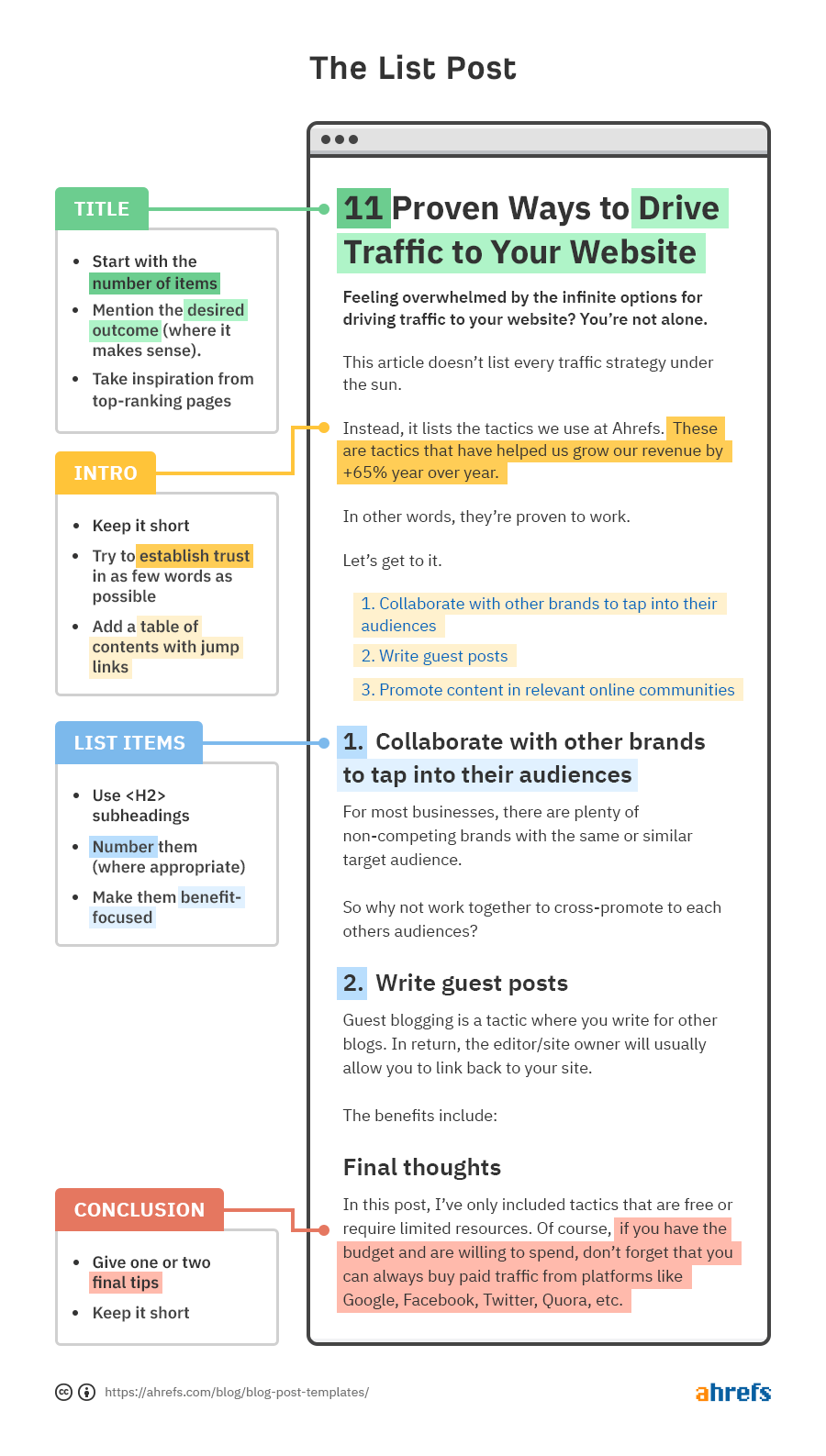
How do you know which template to use?
It depends on your goal. But if you want your written content to stand the best chance of ranking high in Google and attracting organic traffic, choose one that aligns with what searchers are looking for.
For example, if you Google “content writing” (which you probably did), you’ll see that there are quite a few list posts ranking.
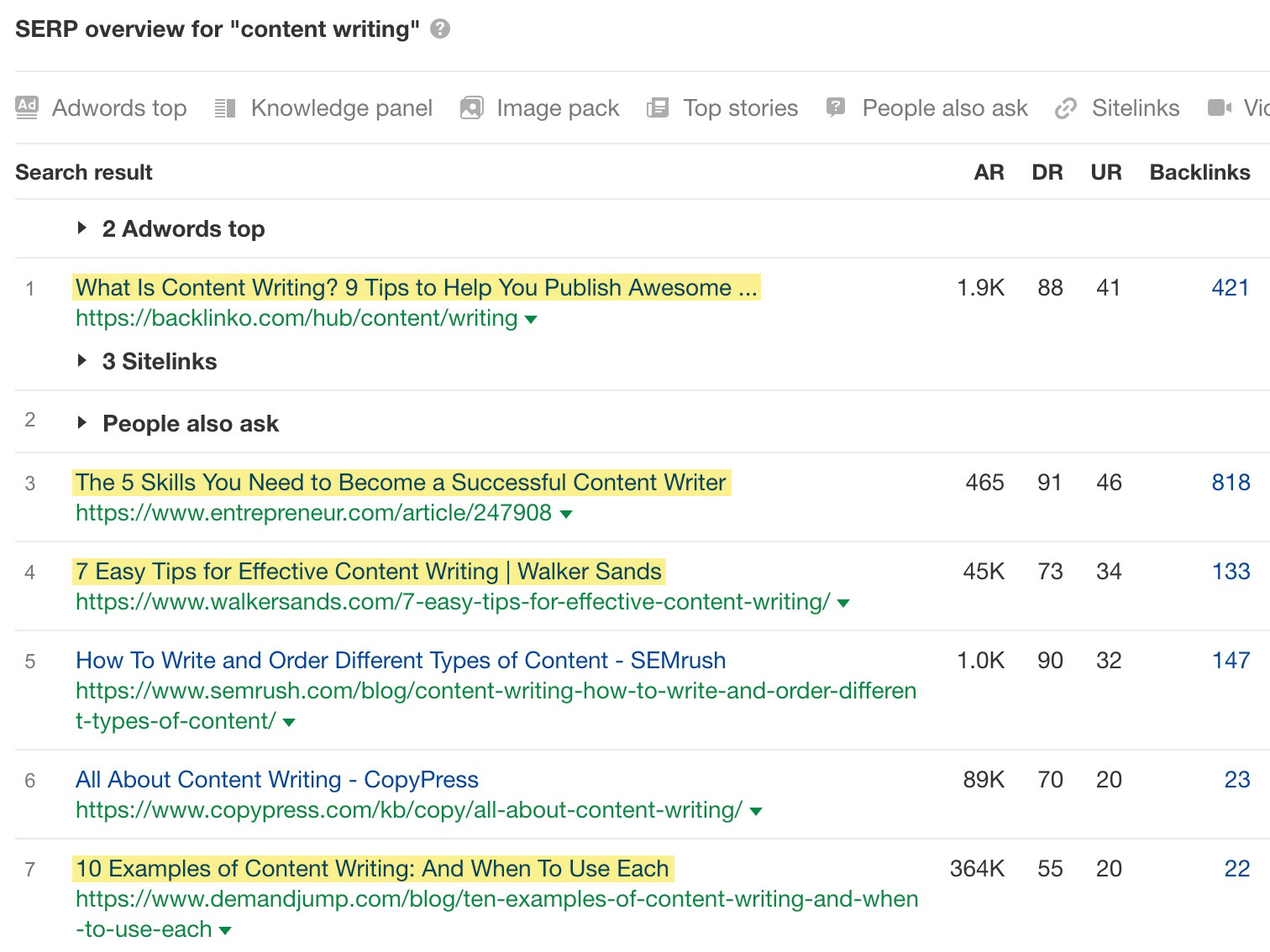
That’s why we went with this angle—because the top-ranking results are a good proxy for what searchers want to see and, as a result, what Google is most likely to rank.
2. Create a proven outline
While a template is enough to get you off the ground, you may not precisely know what you’re going to write about.
For example, we’d hit writers’ block pretty quickly if we tried to write this post from start to finish without fleshing out an outline.
Here’s what it looked like for this article:
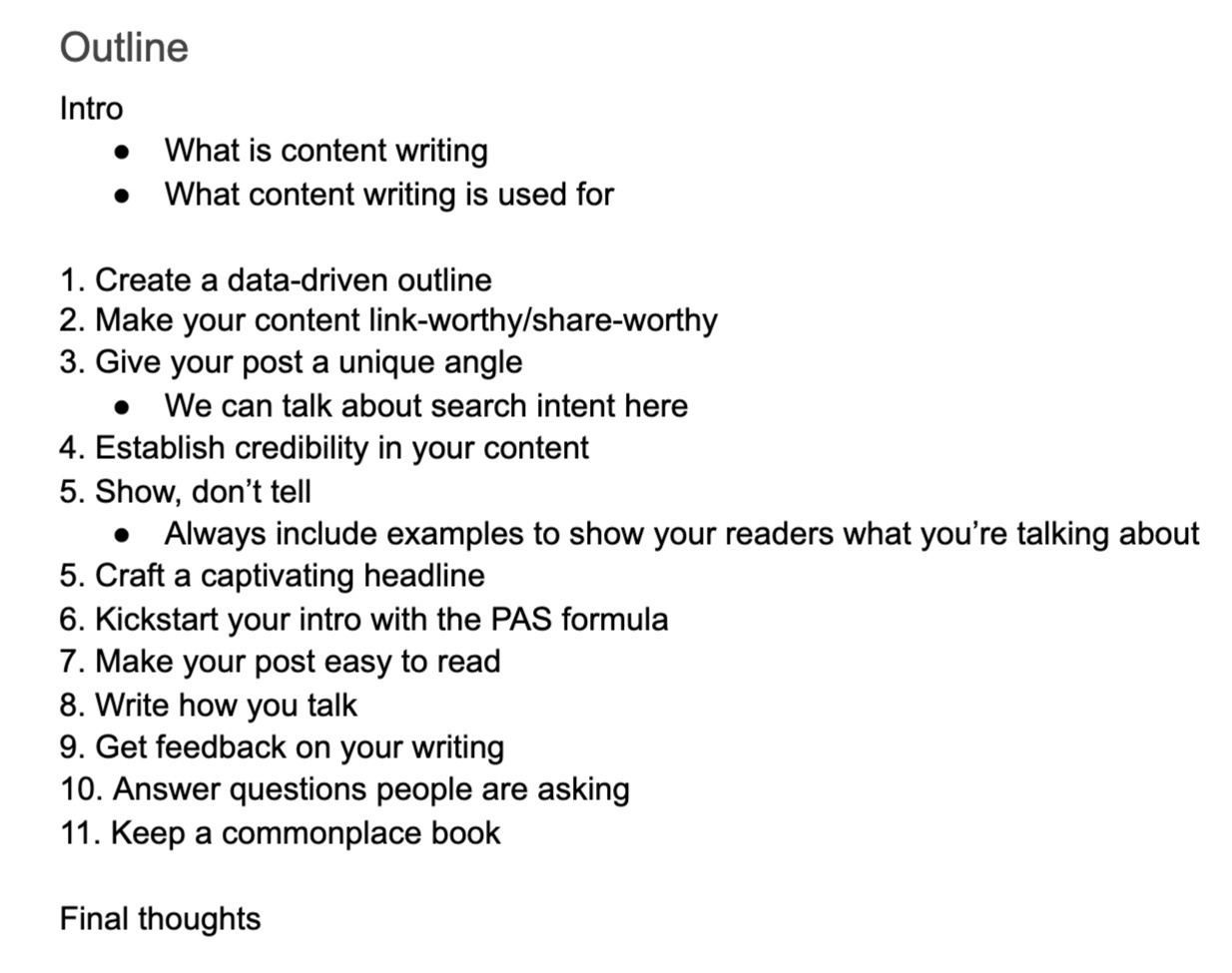
How did we figure out what points to include? Some of the points are our unique ideas, but we also took inspiration from the top-ranking pages.
More specifically, we looked for common themes and points among them to better understand the kinds of questions people wanted answers to and the kinds of advice they were looking for.
For example, using the free on-page report in Ahrefs’ SEO Toolbar, we can see a couple of common themes in the subheadings of top-ranking pages.
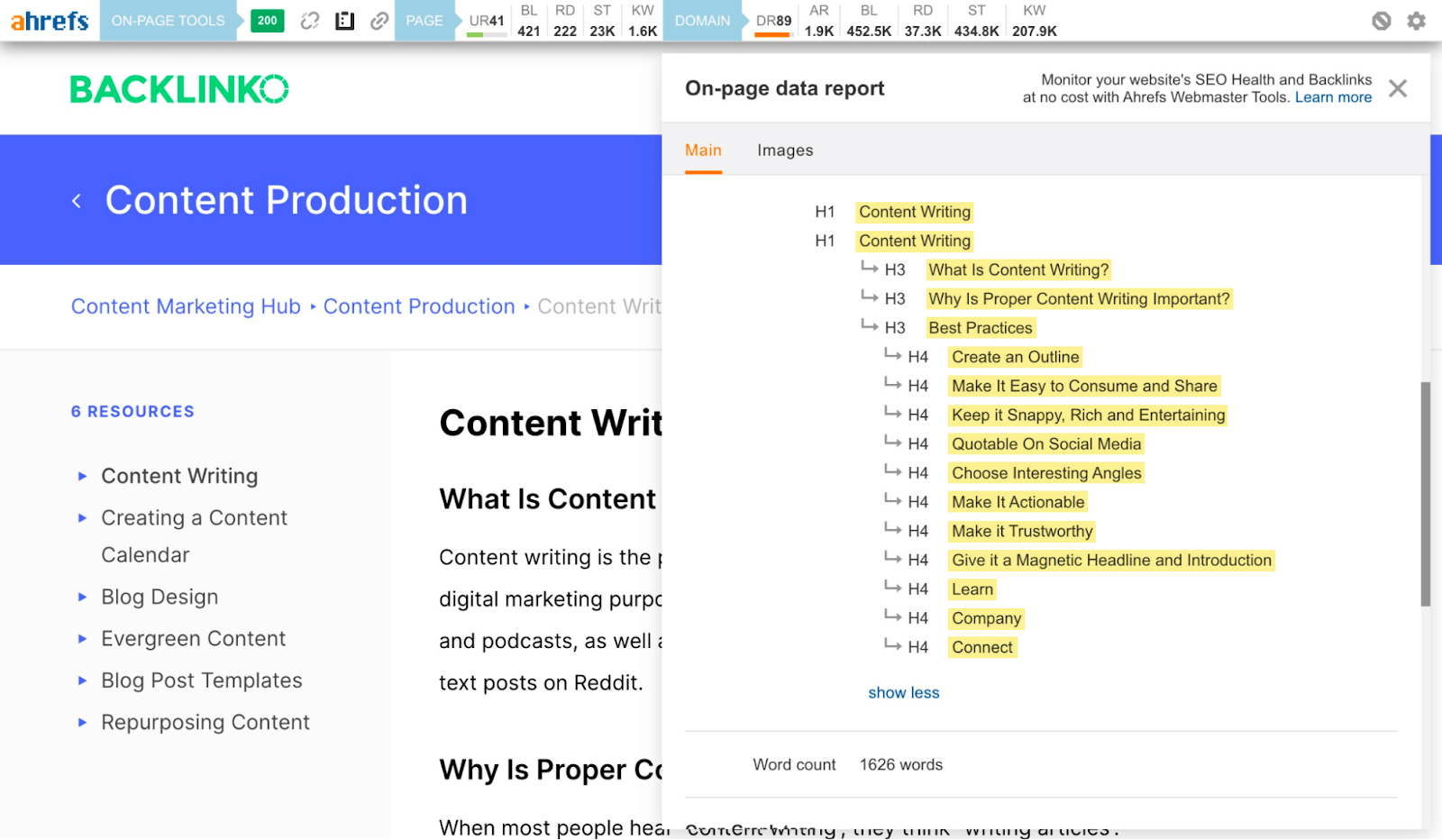
You’ll notice as you read through this post that we included similar points.
3. Make it share-worthy
People share content for all kinds of reasons. Jonah Berger highlights a few in his bestselling book, “Contagious.” People share things because it:
- Makes them look good or helps back up their own point of view/narrative.
- Makes them feel some kind of emotion, e.g., anger, awe, happiness, etc.
- Is related to current events.
- Offers practical value or utility.
- Has already been shared by many others.
Let’s focus our attention on #5.
Getting some initial shares is the key to setting this flywheel into motion, and one way to do that is to build “share triggers” into your content.
You can find “share triggers” by looking for common link reasons in a similar page’s backlink profile—as links are a form of sharing.
Here’s how:
- Go to Ahrefs’ Keywords Explorer
- Search for a topic you’re writing about
- Look at the SERP overview
- Find a similar article with lots of referring domains
- Click on the number in the Backlinks column
- Skim the Anchor and target URL column for commonalities

For example, if we do this for Big Commerce’s post on affiliate marketing, we see quite a few people are linking because of mentioned stats (probably due to principal #1).

If you’re writing about the same topic, mentioning these or similar stats will likely boost shares.
4. Give your post a unique angle
More than 3.5 million blog posts are published every day. If you want to compete, you have to stand out. Differentiate yourself by tackling your chosen topic from a unique angle.
Here’s an example. Procrastination is not a new topic. Yet Tim Urban’s post on procrastination is one of the most popular on his site (or perhaps even the internet). Why? It’s because he tackled it from an angle that no one has seen before.
Rather than a self-help rant about the perils of procrastination, he decided to explain why it happens using cute illustrations: the Instant Gratification Monkey, Panic Monster, etc.

While there are no surefire ways to come up with “angles,” here are a few mental models you can consider:
- Personal experience – Tried doing something before? Tell them about your experience and your lessons learned. We did that with our post on email outreach and SEO certifications.
- Authority – Are you an expert in the field who can offer unique insights? Then don’t shy away from it. Alternatively, if you’re not an expert, can you interview one? We did that with our post on Google penalties.
- Crowdsource – Get the opinions of a few experts, like what we did in our SEO job description post.
- Data – Give evidence and numbers behind popular claims in your niche. See our studies on reciprocal link building and blog post length.
- Contrarian – What happens if you do the opposite of what others did?
5. Establish credibility
Don’t expect people to believe you right from the get-go. Tell them why they should believe you. Why you of all people?
- Are you an expert in the industry? Do you have the credentials to prove it? Can people vouch for you?
- Do you have data or evidence backing up your claims?
- Have you done the thing you said before? Did you experience or try it?
As you can see, most of the questions relate to your angle. The angle you choose for your topic will help to establish the credibility you need. But don’t stop there. Tell them.
Scroll back up to the introduction of this post. I told you we have tons of experience creating and publishing content—hundreds of them, in fact.
See what I did there? 😉
6. Show, don’t tell
Giving advice is easy. But don’t leave your audience in the lurch. Show them exactly what you mean and how it can be done. Always include examples of what you’re talking about.
For example (notice what I did there?), when we talk about creating SEO goals, we don’t just give you the framework. We provide three examples of different goals and how they look in the wild.
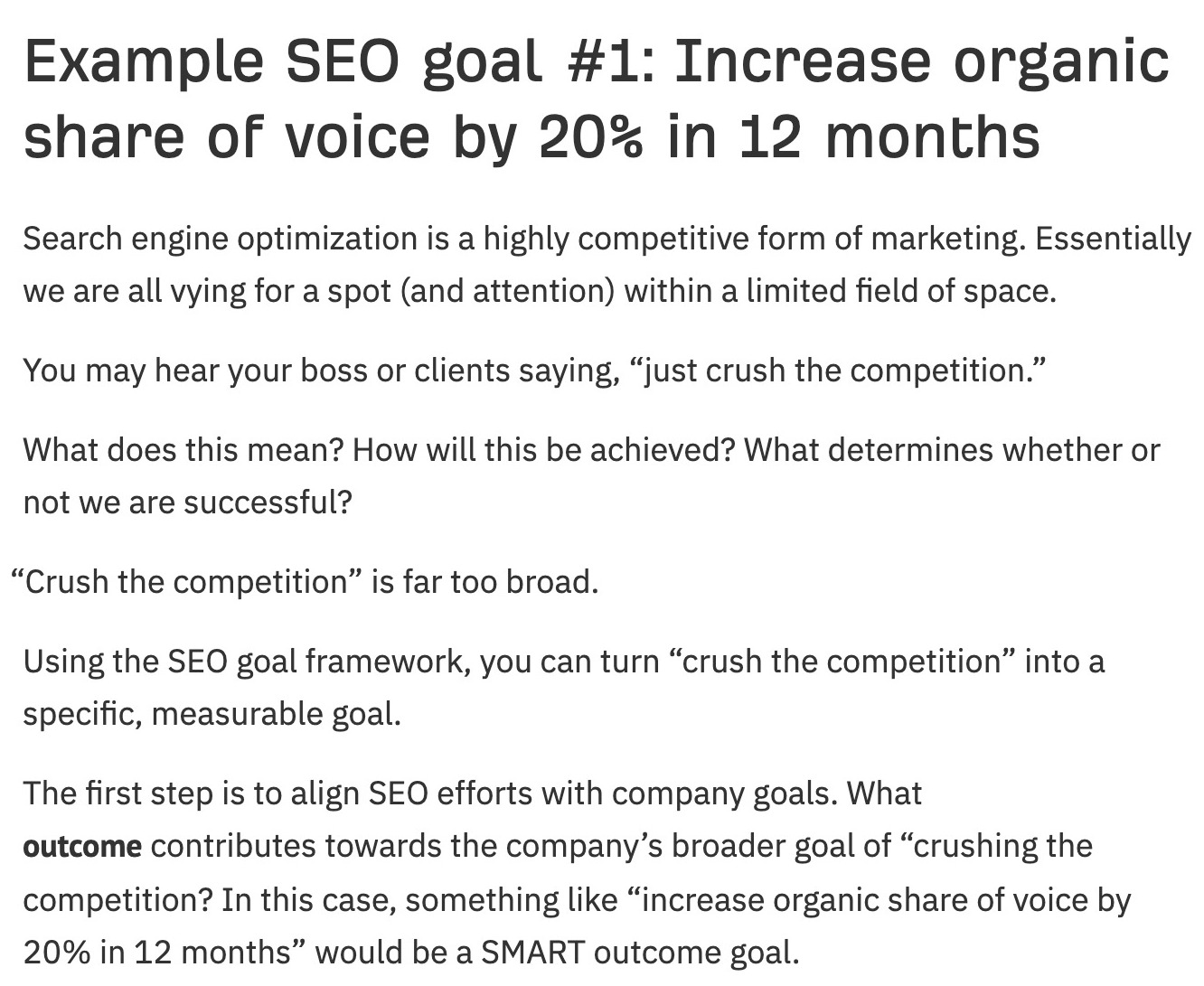
7. Craft a captivating headline
People won’t click on your post if the headline is dull and uninspiring.
You’ll need to craft irresistible headlines that capture people’s attention and make them want to learn more.
How? Use our three-step formula:
- Pick a format –The content format you choose (listicle, guide, review, etc.) will determine how your headline will look.
- Add a winning angle – If you’ve chosen your angle (from point #3), make sure to tell the potential reader about it.
- Make it human – Use adjectives or figures of speech similar to how you’d casually describe the article to your best friend.
Recommended reading: How to Write an Irresistible Headline in 3 Easy Steps
8. Kickstart your intro with the PAS formula
Headlines convince people to click. Intros convince people to read.
Use the Problem-Agitate-Solve (PAS) formula to create a compelling intro. We use this fairly regularly on our blog.
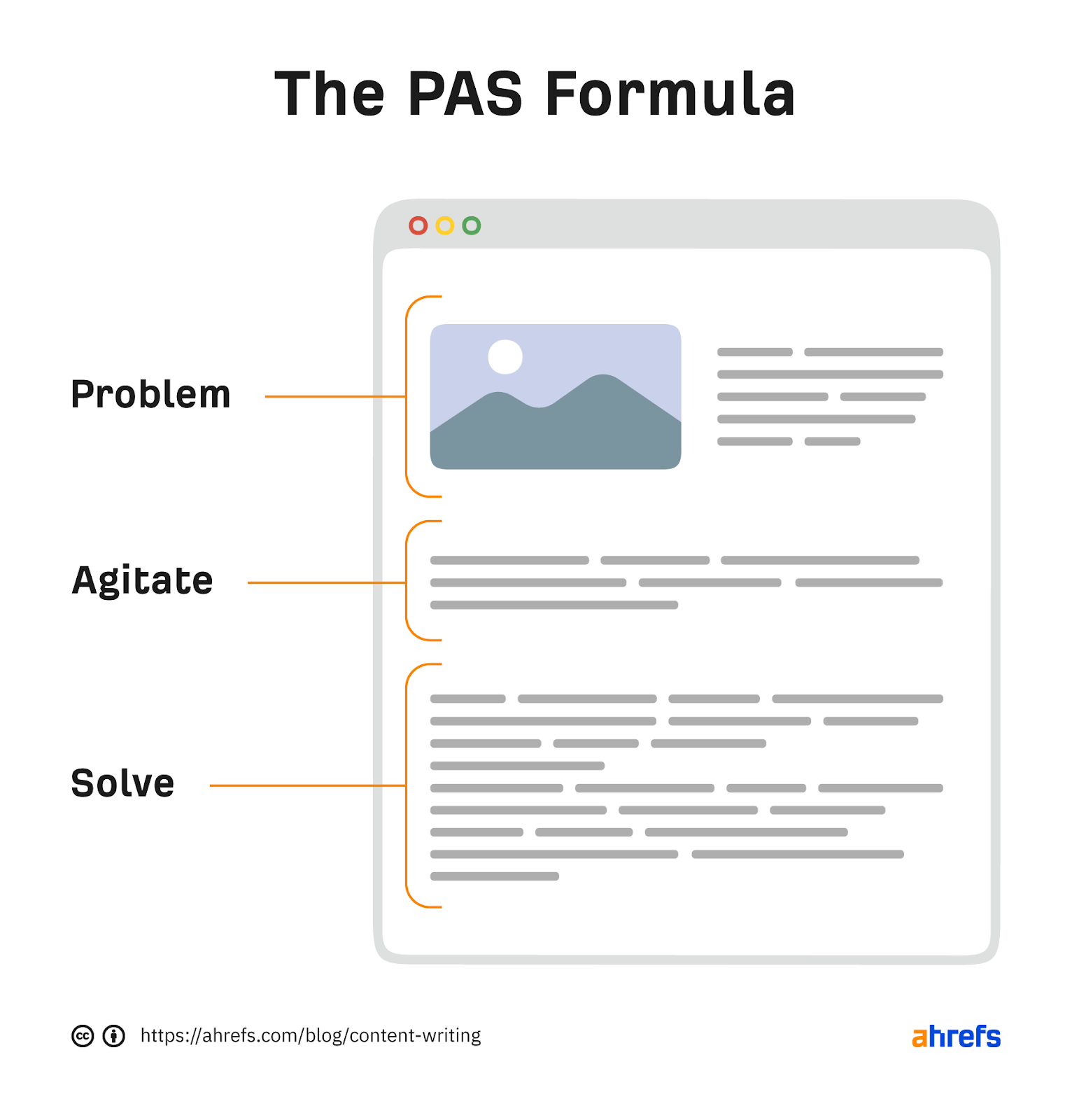
How does it work? You begin by describing the problem:
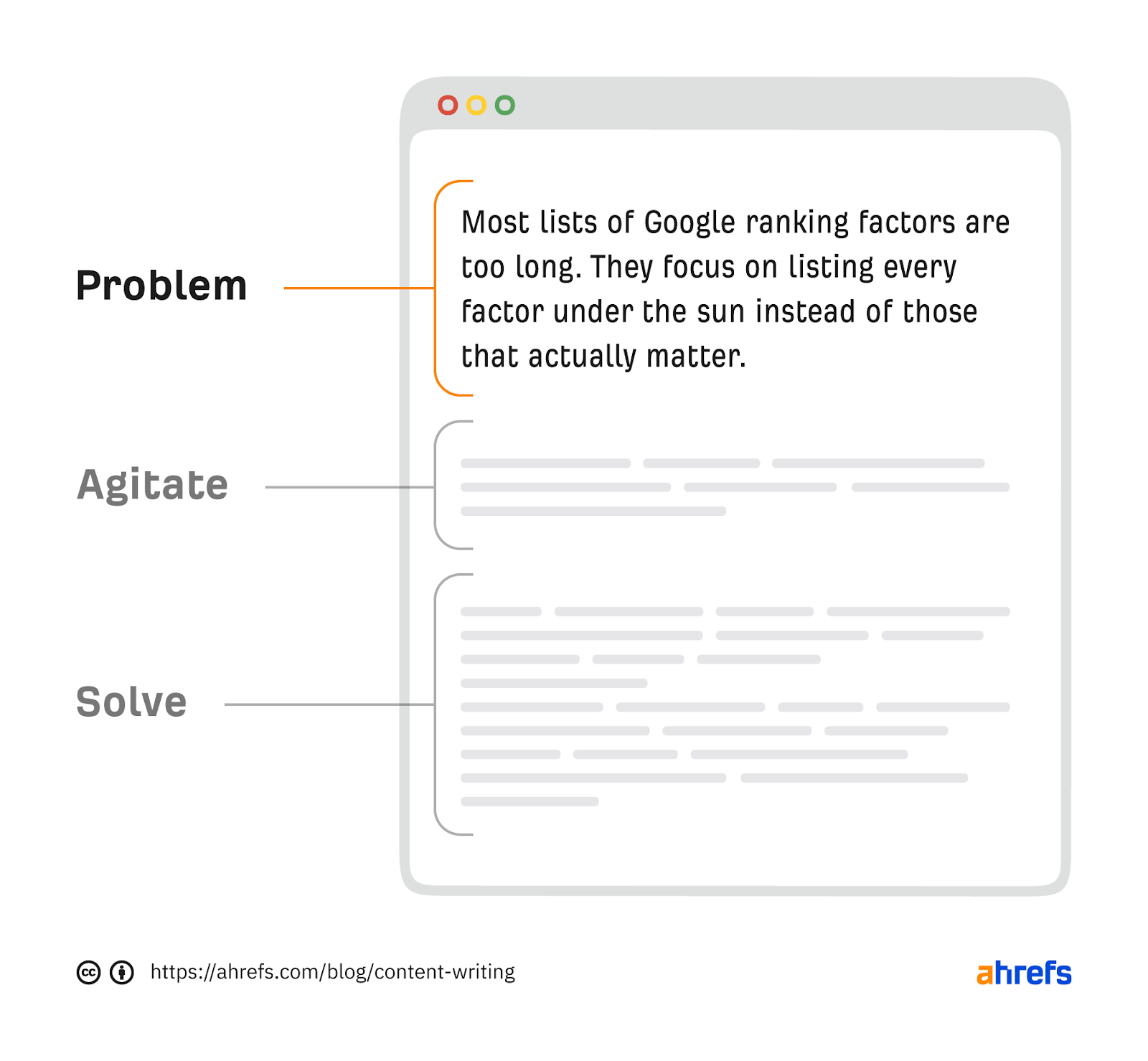
Then, you agitate the problem by digging deeper into their pain:
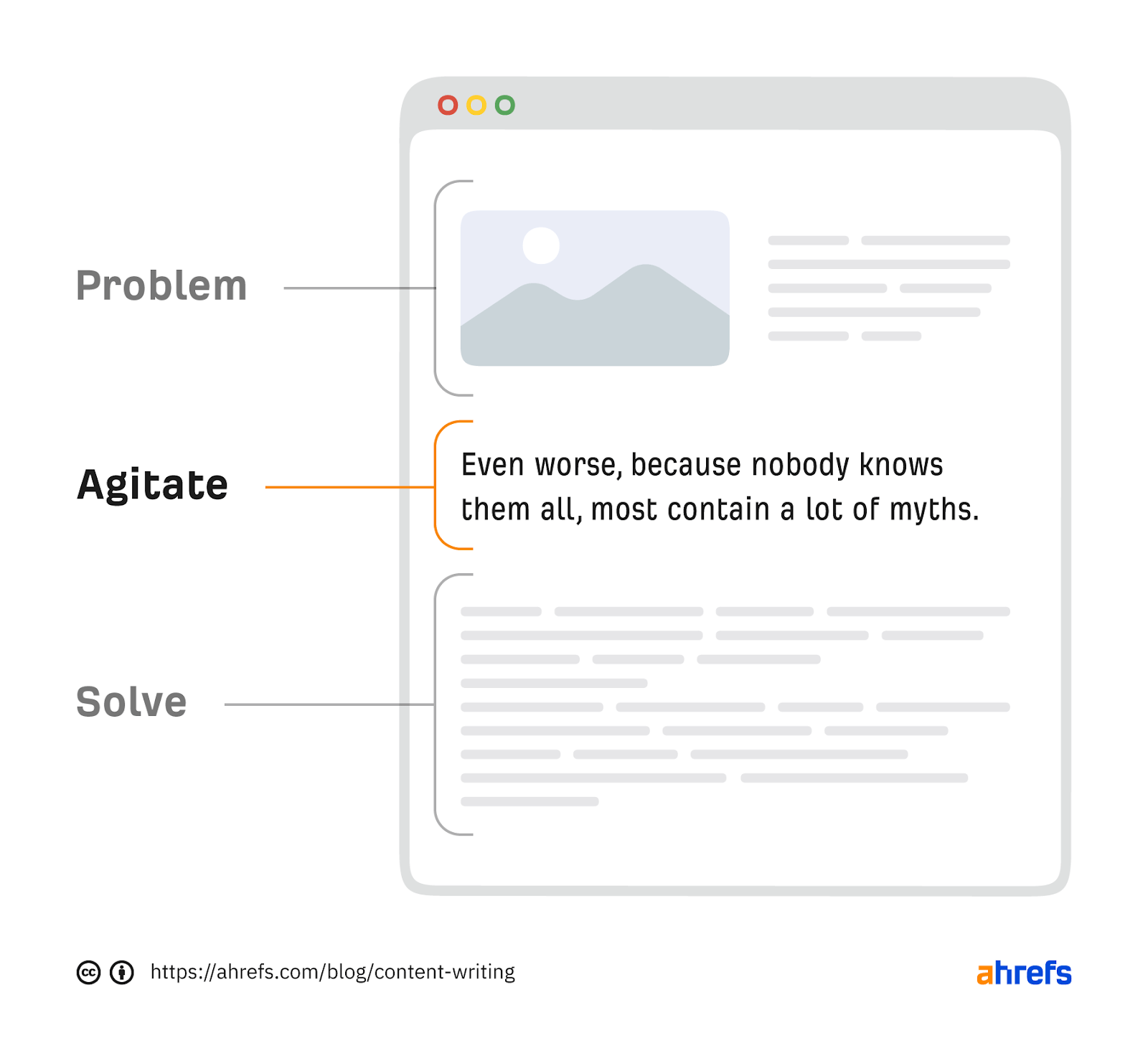
Finally, you show them the way by giving them a solution:
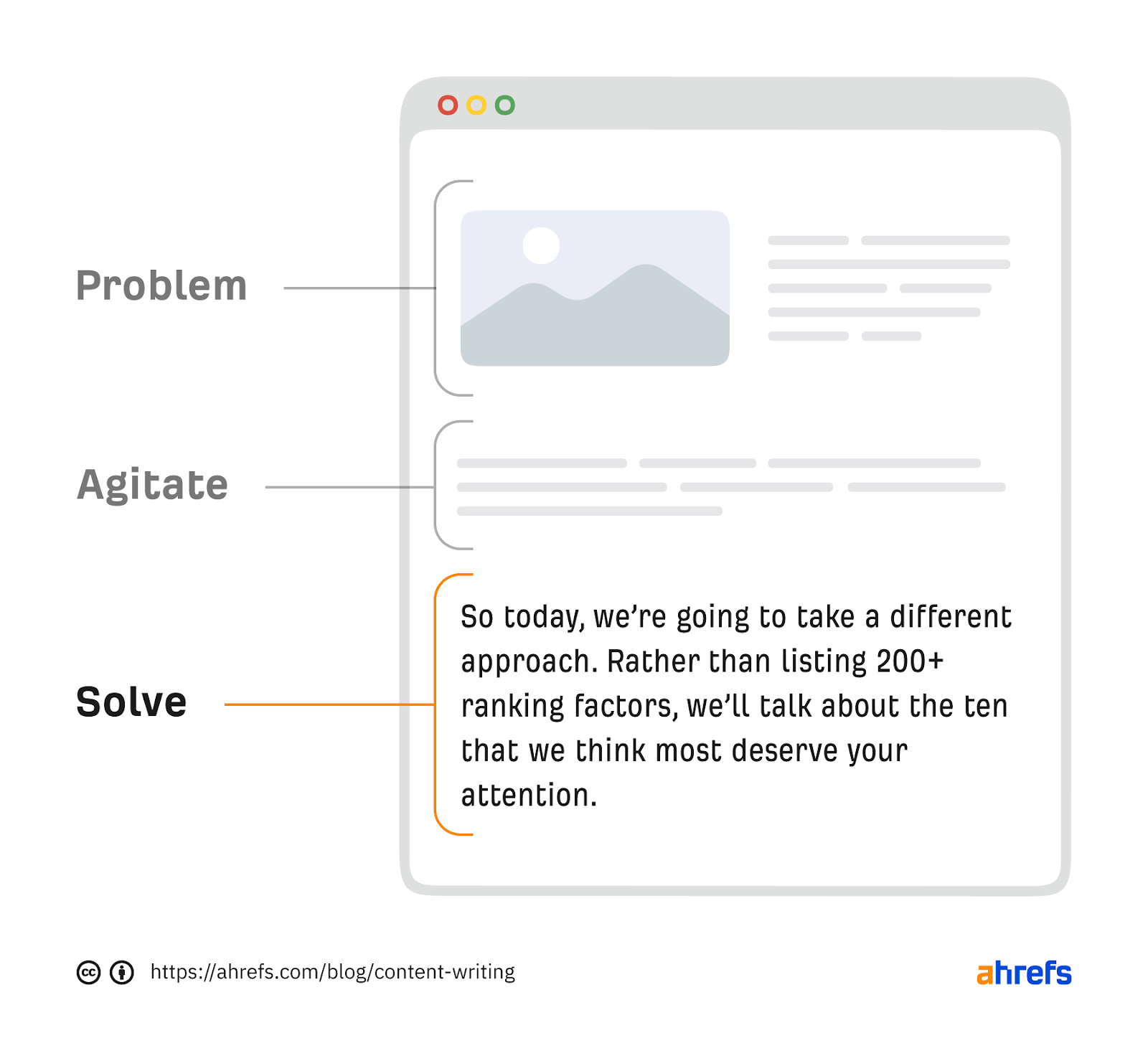
9. Make your post easy to read with the ASMR formula
There’s nothing more daunting than a wall of text.
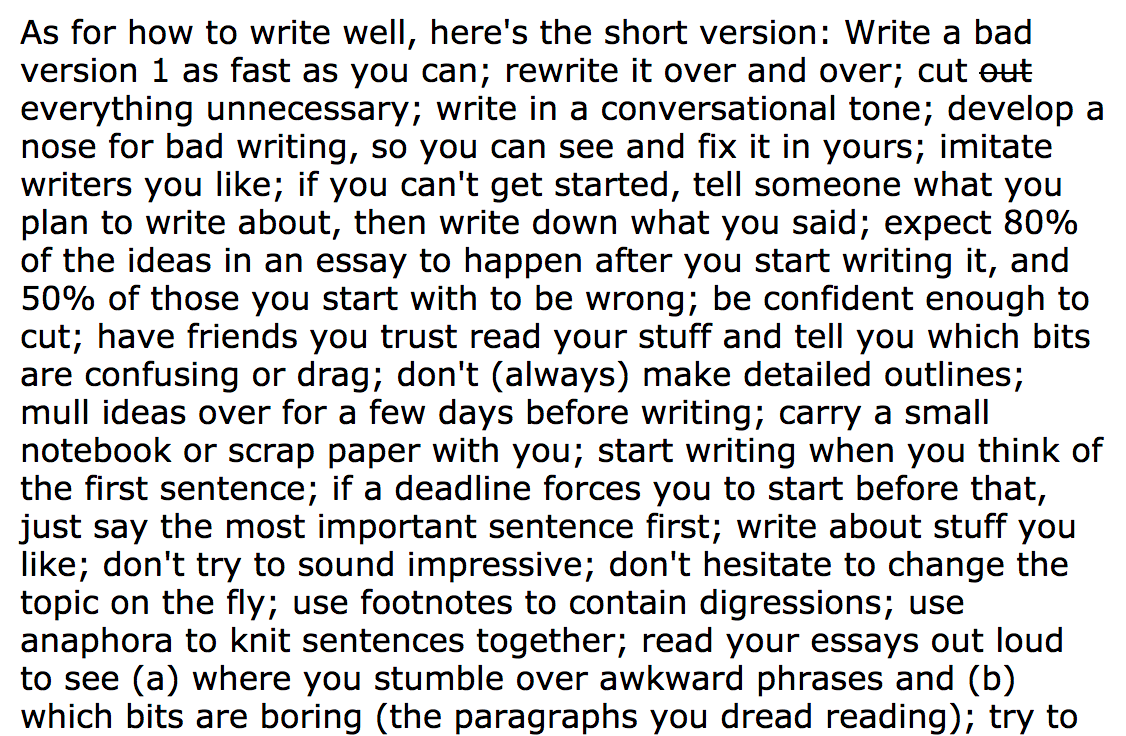
If your article looks like this, you’ll drive people away. Break it up.
Good content writing creates effortless reading. Use the ASMR formula to design your content for easier reading:
- Annotate – Include sidenotes, blockquotes, call-out boxes, and other elements.
- Short sentences and paragraphs – Use the Hemingway editor to find lengthy, complex sentences and shorten them.
- Multimedia – Use videos, images, GIFs, and tweet embeds to illustrate your points.
- Read your content out loud – Discover areas where your writing doesn’t flow smoothly.
10. Write how you talk
Web content writing is friendly and personal. It’s like talking to a friend. There’s no need to pepper big words or write as if you were publishing in Nature.
Your goal is to communicate, not impress people with your extensive vocabulary. So keep it casual and write like how you talk.
11. Get feedback on your writing
As the creator, you’re too close to your work. You won’t be able to spot your mistakes. That’s why a second person’s opinion can be invaluable.
In fact, at Ahrefs, every blog post and script we write is subjected to that scrutiny. We take turns to read each other’s drafts and offer feedback. We point out things like logical loopholes, choppy flow, unclear points, poorly phrased sentences, and so on.
We even let our readers know that each article is not the work of one person. Rather, it is the effort of many people working together to make it great.

Even if you’re working alone, you can get input from another person. It could be your spouse, your family, or even your co-workers. If need be, join writing communities.
Their input will make your work much better.
12. Answer questions people are asking
If people are searching for answers to their questions, that’s how you know those questions are good topics to write about.
The easiest way to find these questions is to use a free keyword research tool. Here’s how to do it:
- Go to Ahrefs’ free keyword generator tool
- Enter a broad topic related to your niche or website (e.g., coffee, tea)
- Toggle the Questions tab
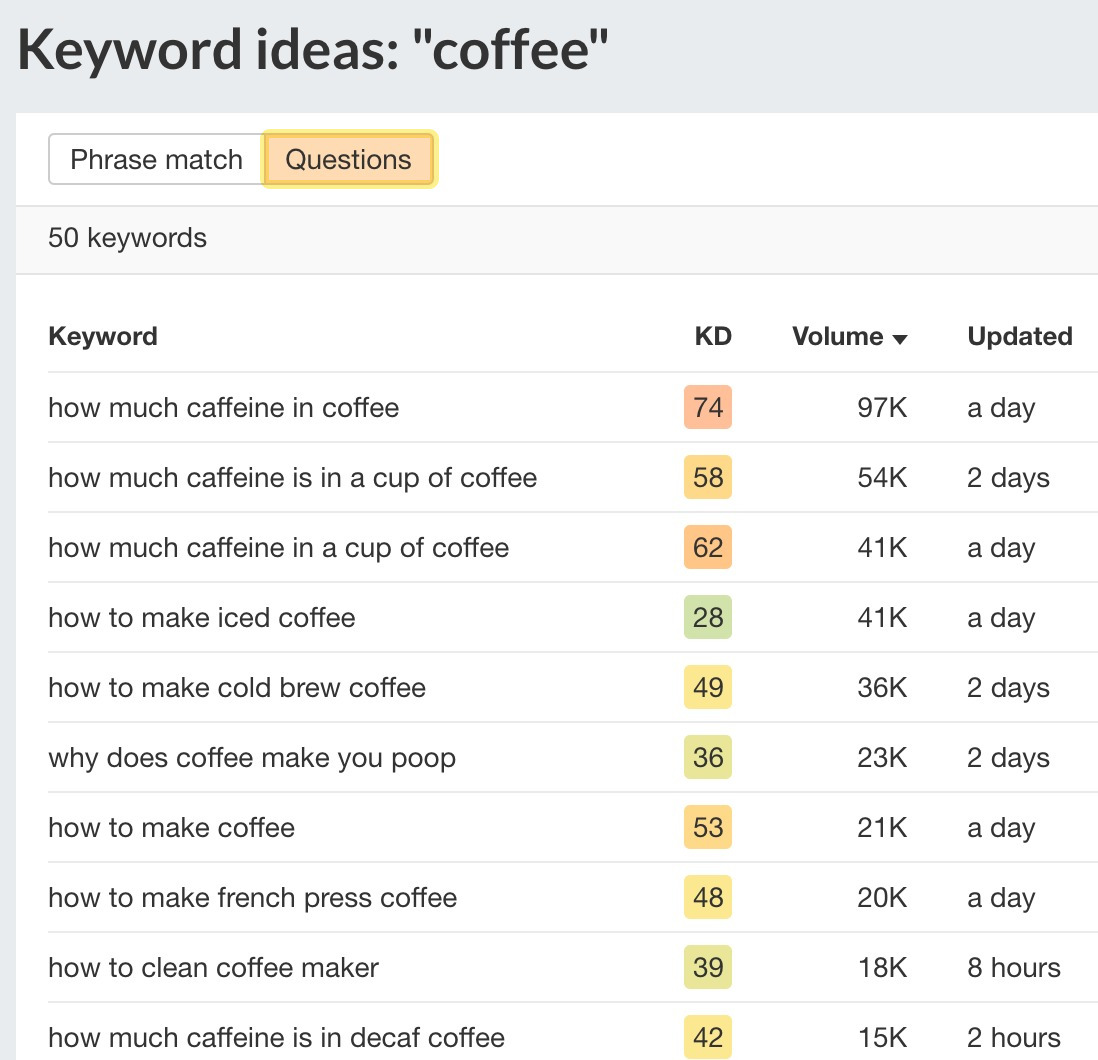
You’ll see a list of questions related to the topic you’ve entered. These questions are listed in the order of search volume, i.e., on average, how many times per month people search for your target keyword.
The higher the search volume, the more people are searching for it.
Look through the list and make a note of all the relevant questions you could potentially answer with a blog post.
Recommended reading: Keyword Research: The Beginner’s Guide by Ahrefs
13. Keep a commonplace book
How do you constantly come up with unique angles and ideas for your content?
The simple answer is that as a content writer, you should always be researching. Be it books, YouTube videos, articles, or podcasts, you should be consuming content and leveling up your knowledge in your field.
Then, store your newfound knowledge in a commonplace book.
What is a commonplace book?
According to Ryan Holiday, a commonplace book is:
… a central resource or depository for ideas, quotes, anecdotes, observations and information you come across during your life and didactic pursuits. The purpose of the book is to record and organize these gems for later use in your life, in your business, in your writing, speaking or whatever it is that you do.
With this resource by your side, you don’t have to look for ideas when it’s time to write. Just pull them out from your commonplace book.
Personally, I keep my commonplace book on Notion. Here’s a glimpse into how it looks:
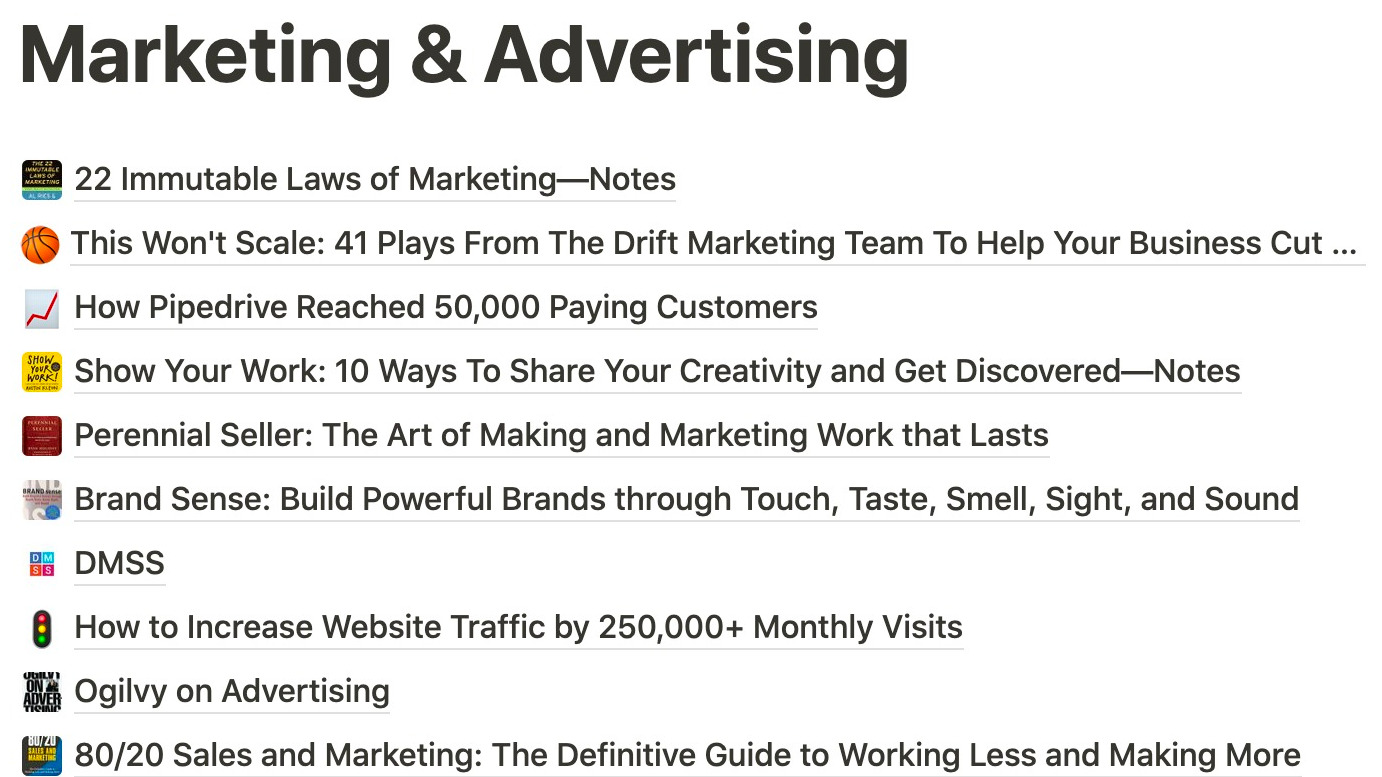
This is my first port of call before I draft any of my blog posts.
Final thoughts
To write amazing content, you have to write.
But if you wait for inspiration to strike before putting pen to paper, you’ll never publish anything. Instead, I recommend committing to a content calendar. This is basically a schedule of when you want to publish new content and what content you want to publish.
Setting deadlines will keep you honest, prevent procrastination, and obligate you to publish.
As the famous playwright Somerset Maugham once said:
I write only when inspiration strikes. Fortunately, it strikes every morning at nine o’clock sharp.
Did I miss out on any important content writing tips? Let me know on Twitter.
